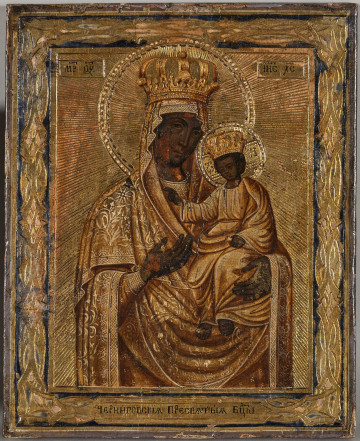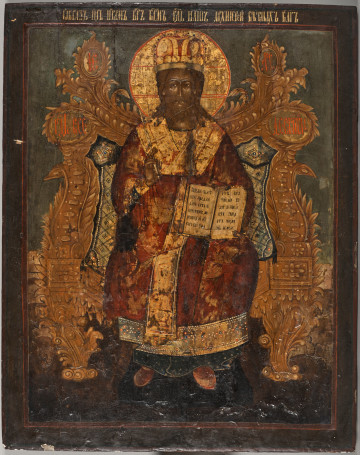
The Mother of God of Hodigitria
19th (?) century
Castle Museum in Łańcut
Part of the collection: Ikony
The tradition of cast metal objects of worship dates back to Byzantine times. In Rus, such products were initially imports, but as early as in the 12th-13th c., local castings began to spread. Well-known centres of metal casting were Kiev, Veliky Novgorod, and Pskov, and in the 16th-17th c. - Moscow. At the end of the 17th c., Old Ritualists (also known as Old Believers) developed their own centres of metal casting. Rejecting the changes introduced to the liturgy by the Patriarch Nikon, they were cast out of the official Orthodox Church, which exposed them to ruthless persecution. Because of this, they fled north and sheltered in the hard-to-reach regions of the Russian coast, located between Lake Onega and the White Sea. The Old Believers, who also established communities in other parts of Russia and abroad, fostered old Russian traditions. In unfavourable circumstances, they ran workshops that produced crosses and icons, including small pendants as well as folding icons joined with hinges. Small objects of worship were easier to hide from law enforcement. Because the Old Believers did not recognise the 'post-Nikon' icons produced in the official Orthodox Church, they used their own products exclusively. The Joy of All Who Sorrow image, which first emerged in 1683 and was reproduced in various visual variants, was one of the few accepted by the Old Ritualists. It appeared soon after the schism in the Church, during the heated disputes between the supporters of renewal and the defenders of old tradition within the Church. The name of the painting comes from the words of the liturgical hymn: "Rejoice, O Virgin Theotokos, full of Grace, Joy of all who sorrow...", see S.12772MŁ, S.12806MŁ, S.12835MŁ, S.12863MŁ. On one of the icon's versions adopted among the Old Ritualists, one can see the sick, suffering and needy resorting to the intercession of the Mother of God, as depicted on the displayed pendant. Teresa Bagińska-Żurawska https://orcid.org/0000-0002-9243-3967
Dimensions
height: 6.2 cm, width: 5.2 cm
Object type
Icons
Technique
cast, enamelling
Material
brass, varnish enamel
Origin / acquisition method
decyzja administracyjna
Creation time / dating
Creation / finding place
Owner
Castle Museum in Łańcut
Identification number
Location / status

19th (?) century
Castle Museum in Łańcut

1800 — 1850
Castle Museum in Łańcut

1800 — 1899
Castle Museum in Łańcut
DISCOVER this TOPIC
Museum of King Jan III's Palace at Wilanów
DISCOVER this PATH
Educational path